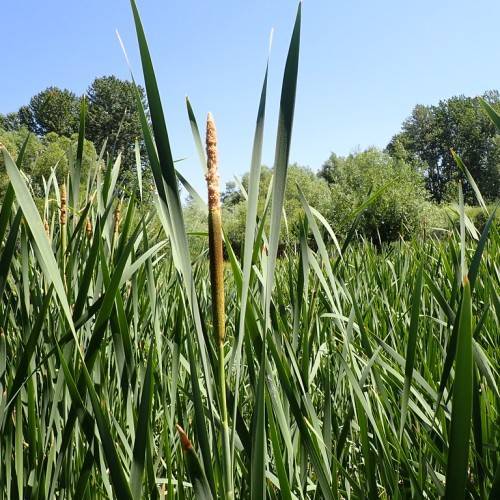
broadleaf cattail
Typha latifolia
Also Known As - bulrushCycle:
Herbaceous Perennial
Watering:
Frequent
Hardiness Zone:
3 - 10
Flowers:
Flowers In Summer
Sun:
Full sun, Part sun/part shade
Soil:
Sandy Loamy Clay
Fruits:
Fruits In Summer Ready In Fall
Leaf:
Yes
Growth Rate:
High
Maintenance:
Moderate
Drought Tolerant:
Yes
Salt Tolerant:
Yes
Invasive:
Yes
Care Level:
Moderate
watering
Broadleaf cattail plants should be watered regularly and evenly. They should be kept moist but not water-logged, which can lead to root rot. During the warmer months, such as spring and summer, they should be given roughly 1 inch of water per week and should be watered deeply at least once a week to help keep the plant healthy and maintain growth. During the cooler months, such as autumn and winter, when the temperatures are lower, they should be given less water; approximately a half inch of water per week should be enough. As with all plants, over-watering can be just as damaging as under-watering, so it is important to keep an eye on your plant to make sure you aren’t giving it too much or too little water.
sunlight
Broadleaf cattail (Typha latifolia) prefer full sun for at least 6 hours a day, although some varieties can tolerate light shade. This species should receive direct sunlight in the morning hours and partial shade for the remainder of the day. It is important to note that the direct afternoon sunlight can cause leaf burn, so the plant should be protected with netting if the sun is too intense. It is also important to make sure the soil is adequately moist for this species, as it does not do well in overly wet or dry environments.
pruning
Broadleaf cattail (Typha latifolia) should be pruned once a year in late spring or early summer. Pruning should be minimal and limited to dead or diseased leaves. Removal of flowers and seed heads will encourage better growth of foliage. When pruning, only remove 1 third of the foliage at a time. This will help keep the cattail looking lush and full with plenty of foliage.
